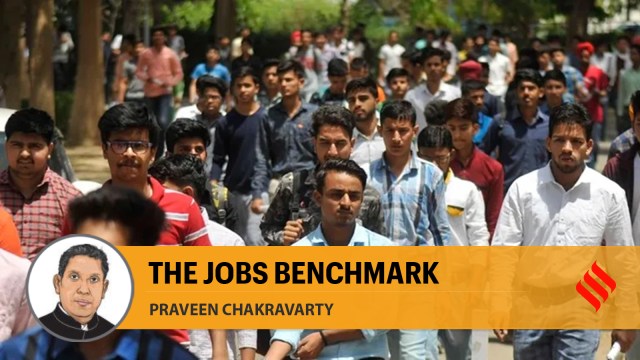
On July 13 in Mumbai, an hour before Prime Minister Narendra Modi attended the wedding reception of the richest Indian’s son, he addressed the public at another event saying, “the Reserve Bank of India (RBI) has released a report stating eight crore (80 million) new jobs have been created in the last 3-4 years. There is no jobs problem in the country”. The significant part about this is not Modi’s false bravado, which is now routine politics, but the crutch of credibility provided by the RBI for this astonishing claim.
When five million youth line up for 60,000 job vacancies in Uttar Pradesh or when 34 million people plead for minimum wage work under the rural employment guarantee scheme (just last month) or when thousands of jobless youth queue up to risk their lives fighting a war for Israel, surely even Modi doesn’t believe his own claim. Should one then construe from Modi’s statement, a sense of despondency and lack of new ideas to resolve the prevailing jobs catastrophe? Perhaps, instead, he is resorting to brushing matters under a carpet of dubious reports by institutions like the RBI.
The shoddiness of the RBI report is staggering. Apparently, India created more manufacturing and services jobs in the last five years than in the previous 13 combined. Citing the RBI report, Modi could have even made a case for a Nobel prize in Economics for pioneering a new economic model in which growth can halve while productive jobs triple. The RBI report shows that 50 million high-quality jobs in manufacturing and services were created in FY 2019-23 when Covid-ravaged GDP growth was a meagre 5 per cent. But when growth was at 11 per cent in the previous five-year period, only 20 million such jobs were created. “Modinomics” has proved many eminent economists wrong about capital-labour theory and has demonstrated that the slower the growth, the faster the job creation. I am being deliberately facetious only to highlight the extent of the government’s desperation to use the RBI to bury India’s jobs crisis.
There have been several policy attempts by the Modi government to spur job creation. “Make in India”, launched in 2015, was supposed to create jobs by boosting manufacturing activity. Instead, manufacturing fell from 17 per cent of the GDP in 2014 to 14 per cent in 2023. In 2019, the government announced sudden corporate tax cuts to incentivise the private sector to invest and create jobs. Instead, private investment as a share of the GDP remained flat. This only led to loss of corporate tax revenues for the government and to offset the loss, the middle class and the poor were taxed more.
In 2020, the government launched a Production Linked Incentive (PLI) scheme with the idea that higher production will trickle down to greater jobs. There is no accurate measure of the number of jobs created under PLI.
Incentivising production does not yield commensurate jobs any longer due to enormous technology-aided productivity gains. For example, the hullabaloo about semiconductor and iPhone manufacturing aside, the sobering fact is that the world’s largest electronics manufacturer, Foxconn, doubled production and revenues between 2010-2020 but did not add more workers. It is then prudent to shift to direct policy interventions for job creation than rely on indirect trickle-down economics. Employment Linked Incentive (ELI) is one such powerful idea.
ELI will incentivise corporates based on the number of new payroll jobs created rather than the number of goods they produce. Under PLI, the government decides the sectors that will be incentivised, which leads to attendant issues of picking the wrong sectors or cronyism. ELI should be sector agnostic and simply pay corporations for the number of jobs they create, regardless of the industry. This will ensure that productivity decisions — such as investment in machinery versus workers — are left to individual firms without any government involvement. A PLI targeted at labour-intensive sectors such as apparel or leather goods is not the same as ELI. The future of work is perhaps about to undergo its most disruptive phase with artificial intelligence, gig work, etc. It is foolhardy to believe that governments can keep up with such rapid changes and pick sectors and firms in a top-down manner based on their current labour intensivity. It is best for governments to keep the focus on the number of new jobs created in the economy on aggregate.
ELI can be implemented using the Aadhaar-based payroll and bank-account infrastructure. This would prevent duplication and ghost employee reporting to claim incentives. Further, it is recommended that the ELI incentive amount be standard for every employee hired rather than be tied to wages of the worker to ensure that there is no adverse government intervention in the wages and every employee is treated the same regardless of their pay or skill.
There are bound to be fears of misuse in the early years of the scheme where corporates could ask their existing employees to resign and rehire them under ELI to claim incentives. These can be handled through efficient administration and supervision. There is also some legitimate apprehension over ELI’s potential impact on overall productivity of India’s economy with the shift from incentivising labour to production. But the current trend of jobless growth is unsustainable. Tilting the balance more towards labour is not just desirable but a precondition to maintain social harmony. The US, UK, Germany, Australia and some other nations have some form of employment incentive programmes for corporations; it is not an untested idea.
India’s jobs crisis is dire. Several well intended policy measures to fix this have failed. But hiding behind the reputational “pallu” of institutions like the RBI and giving up on potential solutions is a double blow. India is ready for ELI, regardless of whose idea it is.
The writer is chairman, All India Professionals’ Congress



